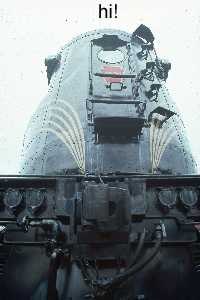This site is for the virtual preservation of the standard electric locomotive of the world, the Pennsylvania Railroad's GG1


This site is for the virtual preservation of the standard electric locomotive of the world, the Pennsylvania Railroad's GG1

4800 (originally 4899) was the prototype for the line and was the only one to have a rivited body. At the behest of Loewy, all later ones were welded. Another asset of the GG1 was strength. A GG1 frame looks more like a bridge than a locomotive. The 4876 lost its brakes and pulled the Federal Express right into Washington Terminal, crashed into the concourse and fell into the basement. It was cut up into small sections so it could be removed from the basement, shipped back to Altoona for reassembly. It was returned to service and still survives today!
With their steam boilers the Gs were intended primarily as passenger locomotives, but adeptly handled freight as well. One of the original orders of the locomotive were built with passenger gearing in the traction motors. As they aged and newer power took over passenger service and many Gs were regeared for freight service. Starting sometime after 1955, many units were equipped with large ungainly air intakes.
The Gs served the Penn Central after the merger and routinely ventured onto New Haven track. After PC's brief life, most Gs went to Conrail where they served until 1979. 40 units were transferred to Amtrak, and 13 to New Jersey Transit where they served until 1981 and 1983 respectively. Despite their sturdy construction, the millions of miles racked up by these units eventually caused frame cracks too extensive to justify repair, given that parts were getting hard to find. The last nail in the coffin was to be the expected catenary frequency change from 25 to 60 Hz. The later rectifier locomotives could use either, but not the all-AC GG1.
Of the 16 units still in existance, 3 are under cover and 8 have been restored to Pensy paint. at least 4 of the units are rapidly deteriorating for lack of upkeep, especially 4876. Most, if not all, G tranformers were drained of the PCB laden coolant oil when they left service. Some may have been refilled with sand or concrete, others removed. Which units may be operable is a mystery.
In as far as the 25Hz power system, despite many reports, the intended frequency change planned in the 1980's never occured and the G's homeland remains 25Hz to this day. It is also reported that there is a 25Hz system somewhere in the gulf coast area.
More information is sought on which units have retained their transformers and what the condition of the transformers is. Also, more detailed information is sought on the status of units 4876, 4879, 4882, 4917 and 4933.
 GG1 Technojargon
GG1 Technojargon
This page is unofficial, and as such does not necessarily represent the views of nor does it have any direct relationship to The Pennsylvania Railroad or its successors, Consolidated Rail Corporation, The New Jersey Department of Transportation, New Jersey Transit, Amtrak, or any other group or person.
Copyrighted photos have been used with permission.
 This site is presented by Spike Systems.
This page and all other pages and files within this site not explicitly Copyrighted
are Copyrighted © 1994-2001 Christopher D. Coleman. They may
not be distributed without explicit permission. All rights are reserved.
This site is presented by Spike Systems.
This page and all other pages and files within this site not explicitly Copyrighted
are Copyrighted © 1994-2001 Christopher D. Coleman. They may
not be distributed without explicit permission. All rights are reserved.
 This page was last updated November 4, 2002 by
Chris Coleman,
This page was last updated November 4, 2002 by
Chris Coleman,